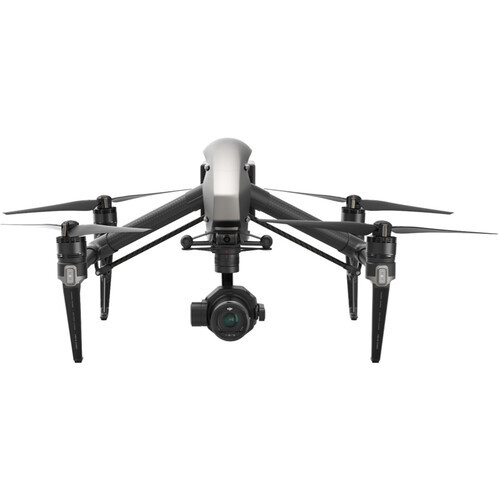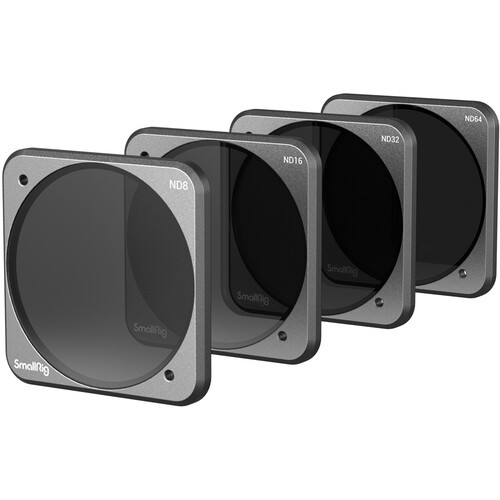With the Inspire 2 Advanced Kit with Zenmuse X7 Gimbal & 16mm/2.8 ASPH ND Lens from DJI, you get a complete aerial imaging solution right out of the box. The Zenmuse X7 gimbal offers 3-axis stabilization while its camera captures footage at up to 6K resolution at either 17:9 or 16:9 aspect ratios. In addition to 6K, the camera can record DCI 4K at 30 fps, and UHD 4K at a smoother 60 fps. For still image shooting, hi-res 24MP pictures can be taken, and all your aerial footage can be saved on optional microSD or DJI CINESSD drives. The addition of the 16mm ASPH ND lens delivers an open f/2.8 aperture to accommodate for low-light conditions, or to reduce depth of field for an augmented bokeh effect.
Not all the power to be found in the Inspire 2 is in the recording functionality. DJI beefed up the flight capabilities of the Inspire 2. Able to accelerate to 50 mph in 4 seconds and reach a top speed of 58 mph, the Inspire 2 can follow fast-moving subjects for dramatic sports and action footage. The flight prowess of the Inspire 2 doesn't come at the expense of battery life. With the two included LiPo batteries onboard, up to 27 minutes of flight time can be had on a full charge.
Advanced obstacle avoidance has also made its way to the Inspire 2. Built into DJI's FlightAutonomy system, objects in front of, below, and above the quadcopter can be detected and avoided automatically. The Inspire 2 can even remember flight paths in case of an emergency return-to-home without GPS enabled. What's more, using the onboard 2-axis stabilized FPV camera, the pilot can navigate the Inspire 2 without being limited to the gimbal camera's field of view.
Advanced Obstacle Sensing
Forward and downward vision systems enable the Inspire 2 to detect obstacles up to 98.4' ahead, allowing for protected flight at up to 34 mph at a controllable attitude angle of 25°. Upward-facing infrared sensors scan obstacles 16' above, adding protection when flying in enclosed spaces. Obstacle-sensing systems are active during normal flight, RTH, and all Intelligent Flight Modes.
Spotlight Pro
Spotlight Pro is a powerful tracking mode that allows even single pilots to capture complex, dramatic images. It uses advanced, visual-tracking algorithms to lock onto a subject during flight, regardless of the direction that the Inspire 2 flies, creating shots that would once have required a dedicated camera operator. If the gimbal comes close to reaching its rotation limits, the Inspire 2 itself will rotate in the same direction without affecting flight control or the shot being captured to free up gimbal movement.
Spotlight Pro has two shooting modes: Quick and Composition. In Quick mode, select an object to begin tracking. In Composition mode, select the subject and the tracking position. When the subject enters the preset tracking position, press the shortcut to begin tracking. The gimbal can be moved during shooting for composition adjustments. Spotlight Pro is available in all Intelligent Flight Modes including ActiveTrack, TapFly, Waypoint, and Point of Interest.
TapFly
The 2-axis onboard FPV camera separates the flight view from the main camera view, effectively giving the Inspire 2 a dedicated "tap-to-fly" camera. Tap a point onscreen in the FPV view to set a flight route and the Inspire 2 will automatically fly along that route, leaving the pilot to focus on gimbal movement.
ActiveTrack
The ActiveTrack Mode allows the Inspire 2 to recognize a range of objects, from people to bikes to cars to boats. Tracking profiles that can be adjusted based on the subject being tracked means greater tracking precision.
Smart Return Home
Forward and downward vision systems allow the Inspire 2 to create a real-time map of its flight route as it flies. If the video transmission system signal is lost and Smart Return Home is enabled, it can fly home along its original route and change to a straight line when it regains a signal. As it returns, it will use the primary camera to identify obstacles as far as 656' in front, allowing it to plan a safe route home. It is also able to reconnect more quickly after losing connection.
Video Transmission System
The Inspire 2 features DJI's Lightbridge technology. This iteration has an effective transmission distance of up to 4.3 miles (under ideal conditions) and can deliver both 1080p and 720p video, as well as the FPV view to the pilot and camera operator. Users can also switch between 2.4 GHz and 5.8 GHz control frequencies to avoid interference for greater signal stability.
Master and slave setups are also supported. The master controller can transmit an HD video signal to the slave controller up to 300' away without image quality loss.
Broadcast Mode
Broadcasters can broadcast direct from the Inspire 2 using its dedicated 1080i50 and 720p60 transmission signal. Aerial live streaming direct to TV is as simple as connecting the Inspire 2 transmitter to the satellite truck.
Powerful Flight Performance
The propulsion system can thrust the Inspire 2 up to 58 mph and allows for descents up to 29 feet-per-second and ascents up to 19 feet-per-second. It can accelerate from 0 to 50 mph in just four seconds and flies at a maximum attitude angle of 40°. The two controller sticks on the transmitter are tuned for more sensitivity, making delicate maneuvers easier.
Dual-Battery Design
Dual batteries mean that, if a problem occurs on one battery, the other can continue flight long enough for a safe landing. At the same time, the Inspire 2 propulsion system is driven by a PWM signal with serial port signal redundancy so that if PWM signals are lost, transmission will continue through the serial port.
Cendance Remote Controller
This remote puts a host of controls at your fingertips. Pilot using the dual thumbsticks and adjust settings on the Inspire 2 with five analog control channels and over ten customizable buttons. The Cendance can be used with an optional CrystalSky monitor for viewing live drone footage, and the remote can be expanded via HDMI, SDI, USB, and CAN ports. If you have an Inspire 2 remote or another Cendance, they can be linked to support dual operators.
Performance
Maximum Takeoff Weight 8.8 lb / 4 kg
Maximum Horizontal Speed 58 mph / 93.3 km/h
Maximum Ascent Speed 19.7 ft/s / 6 m/s
Maximum Descent Speed 29.5 ft/s / 9 m/s
Flight Ceiling 8200' / 2499.4 m
Maximum Flight Time 27 Minutes
Maximum Tilt Angle 40°
Hovering Accuracy ±1.64' / 0.50 m Vertical with GPS
±4.92' / 1.50 m Horizontal with GPS
Vision System
Vision System Downward, Forward
Velocity Range 32.8 ft/s / 10 m/s at 6.56' / 2 m
Maximum Altitude 33' / 10 m
Obstacle Sensory Range 2.3 to 98.4' / 0.7 to 30.0 m
Forward Field of View 60° (Horizontal)
54° (Vertical)
Operating Environment Surface with Clear Patterns at >15 lux
Infrared Sensing System
Obstacle Sensory Range 0.0 to 16.4' / 0.0 to 5.0 m
Field of View 5° (Vertical)
Camera
Sensor Resolution Actual: 24 Megapixel Megapixel
Maximum Aperture f/2.8
ISO Range Photo: 100 to 25,600
Video: 100 to 6400
Shutter Speed Electronic Shutter
1/8000 to 8 Seconds
Mechanical Shutter
1/1000 to 8 Seconds
Still Image Support JPEG / DNG
Photo Modes Burst Shooting
Gimbal
Number of Axes 3 (Pitch, Roll, Yaw)
Control Range Pitch: -125 to 40°
Roll: -20 to 20°
Angular Speed Pitch: 180°/s
Roll: 180°/s
Yaw: 360°/s
Flight Battery
Battery Chemistry Lithium-Ion Polymer (LiPo)
Capacity 4280 mAh / 97.58 Wh
Battery Configuration 6 S / 22.8 V
Weight 1.1 lb / 0.5 kg
Charger
Output Voltage 26.1 V
Power Rating 180 W
General
Number of Rotors 4
Operating Temperature 14 to 104°F / -10 to 40°C
Diagonal Size 23.8" / 60.5 cm (Without Propellers)
Weight 7.25 lb / 3.29 kg (Including Battery)
Packaging Info
Package Weight 30 lb
Box Dimensions (LxWxH) 25.7 x 25.6 x 12"











